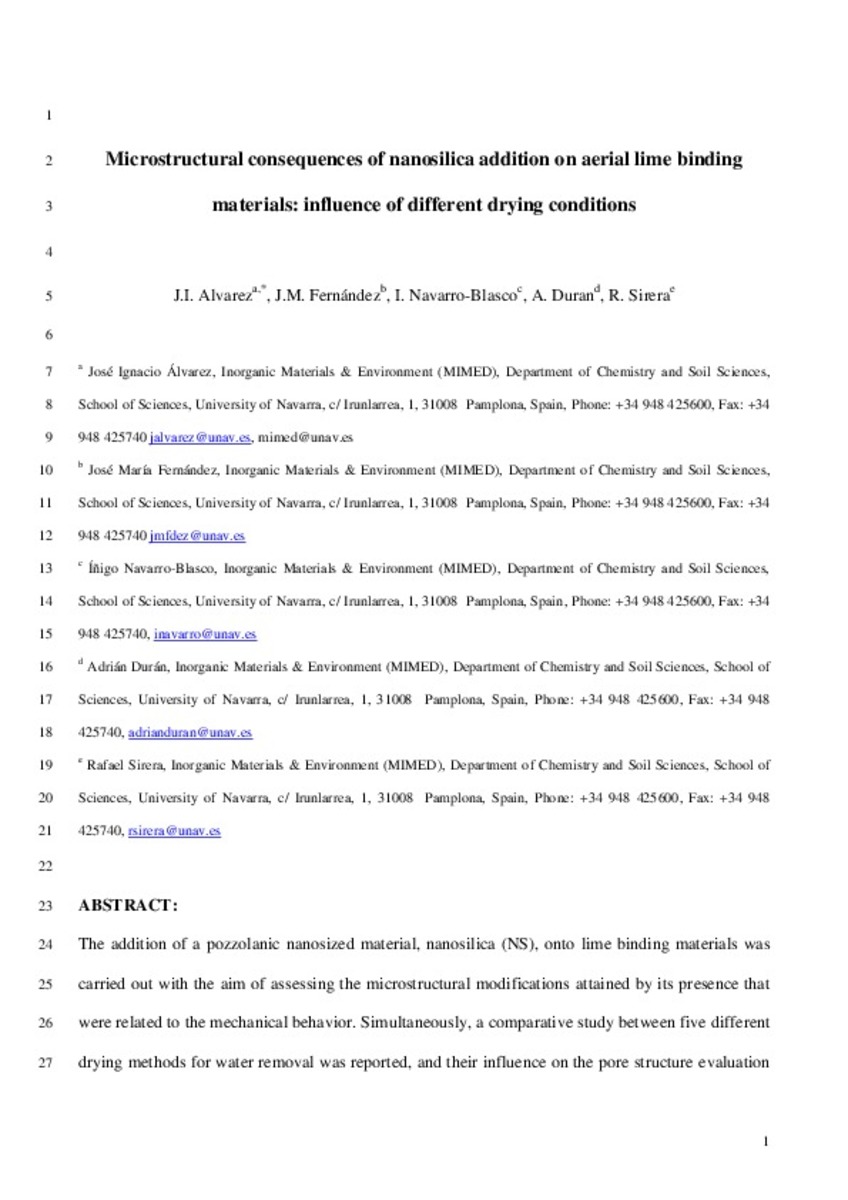Full metadata record
| DC Field | Value | Language |
|---|---|---|
| dc.creator | Alvarez-Galindo, J.I. (José Ignacio) | - |
| dc.creator | Fernandez-Alvarez, J.M. (José María) | - |
| dc.creator | Navarro-Blasco, I. (Iñigo) | - |
| dc.creator | Duran-Benito, A. (Adrian) | - |
| dc.creator | Sirera-Bejarano, R. (Rafael) | - |
| dc.date.accessioned | 2013-04-17T13:45:29Z | - |
| dc.date.available | 2013-04-17T13:45:29Z | - |
| dc.date.issued | 2013-06 | - |
| dc.identifier.citation | Alvarez JI, Fernandez JM, Navarro-Blasco I, Duran A, Sirera R. Microstructural consequences of nanosilica addition on aerial lime binding materials: Influence of different drying conditions. Materials Characterization 2013; 80:36-49 | es_ES |
| dc.identifier.issn | 1044-5803 | - |
| dc.identifier.uri | https://hdl.handle.net/10171/28294 | - |
| dc.description.abstract | The addition of a pozzolanic nanosized material, nanosilica (NS), onto lime binding materials was carried out with the aim of assessing the microstructural modifications attained by its presence that were related to the mechanical behavior. Simultaneously, a comparative study between five different drying methods for water removal was reported, and their influence on the pore structure evaluation is discussed. Solvent-exchange with isopropanol and freeze-drying methods were shown to remove the excess of free water efficiently, allowing us to measure the gel pores (< 10 nm) of the calcium silicate hydrated (C-S-H) phases and yielding the largest surface area values. By using vacuum drying, oven drying at 60ºC or oven drying at 105ºC macro-, meso- and micropores could not be properly measured. On the other hand, the addition of NS dramatically altered the mesopore range. As a result of the intercalation of NS particles between lime particles, a drop in the population of large and medium capillary pores (in the range of 20-100 nm) was observed, leading to reduced overall porosity. The NS was clearly proven to act as nanofiller. Finally, this filling effect of NS together with the development of C-S-H gel, as a consequence of the pozzolanictype reaction proved by the increase of population in the micropore range, notably enhanced the compressive strength of the lime binding materials, yielding values more than twice those of the NS-free materials. | es_ES |
| dc.language.iso | eng | es_ES |
| dc.publisher | Elsevier | es_ES |
| dc.rights | info:eu-repo/semantics/openAccess | es_ES |
| dc.subject | Nanosilica | es_ES |
| dc.subject | SEM | es_ES |
| dc.subject | Pore size distribution | es_ES |
| dc.subject | TEM | es_ES |
| dc.subject | Mesopore | es_ES |
| dc.subject | Compressive strength | es_ES |
| dc.title | Microstructural consequences of nanosilica addition on aerial lime binding materials: influence of different drying conditions | es_ES |
| dc.type | info:eu-repo/semantics/article | es_ES |
| dc.type.driver | info:eu-repo/semantics/article | es_ES |
| dc.identifier.doi | http://dx.doi.org/10.1016/j.matchar.2013.03.006 | es_ES |
Files in This Item:
Statistics and impact
Items in Dadun are protected by copyright, with all rights reserved, unless otherwise indicated.






